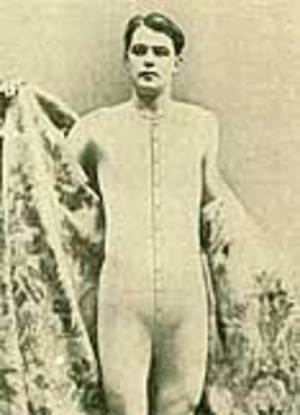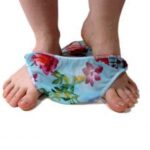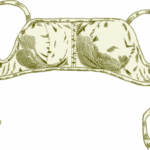By the turn of the 20th century, the new mass-produced undergarment industry was booming (The invention of the cotton gin in the second half of the 18th century made cotton fabrics widely available, thus allowing factories to mass-produce underwear). For the first time, people began buying underwear in stores rather than making them at home. And as a direct result, many underwear producers came up with all sorts of innovate designs and concepts to compete.
The Hanes Company emerged from this boom, as a top manufacturer of union suits (This was the standard undergarment in the late 19th century for men, women, AND children. They were usually made of knitted material, featured a drop flap in the back (for toilet visits), and provided coverage from the wrists to the ankles. You may know them better as “long johns”.
The corset was relaxed, due to new, flexible yet supportive materials (the whalebone and steel were removed; their original purpose was to form the figure, to produce a tiny “wasp” waist, which was considered a sign of beauty by the 1860s. But there were side effects; pain and damage to internal organs and bones were caused by tight lacing. A “health” corset was invented by Inez Gaches-Sarrante with a straight-fronted bust to help support the wearer’s muscles); the “emancipation” or “liberty” bodice offered an alternative to the corset (In the U.K. and Australia, this item became a standard for girls and women.
The underwear boom begat underwear advertising (comfort and durability were stressed); in 1911, the first such print ad in the U.S. was featured in the Saturday Evening Post-oil paintings by J.C. Leyendecker of the “Kenosha Klosed Krotch”.
By the end of the 1910s, long johns were split into uppers and lowers (by the Charles Knitting Co.), thus inventing the modern undershirt and drawers.
The first brassiere to be patented (not considered the very first bra) was by American socialite Mary Phelps Jacob (no relation!), under the name Caresse Crosby in 1914. It was marketed throughout the U.S., but there wasn’t much interest in the new item and sales were minimal, so for $1,500, she sold the patent rights to the Warners Co… and you know what happened. A few years later that patent was worth fifteen million dollars! (And within a year, breasts were measured in inches rather than being grouped as small, medium, or large. Warners also claimed that THEY invented the first bra in 1902. Several people lay claim to this, but Phelps Jacob DID patent it first. She should have hung on to it!)
In 1912, the first professional underwear designer shop was started in the U.S. by French immigrant Lindsay Layneau Boudreaux; the company was “Layneau”. It was short-lived, however, as it closed within one year.
By decade’s end, “bloomers” (invented by Elizabeth Smith Miller, but made popular by Amelia Bloomer) became the “must have” item for the Gibson girls of the time (this group and the limit of metal during World War I speeded the corset’s demise. The bra was picked up!).
Did you know that World War I soldiers were issued button-front shorts? The buttons were attached to a separate piece of cloth, or yoke, that was sewn on the front. The tightness of the fit was adjusted by ties on the side. This item became so popular that it began replacing long johns by war’s end (Rayen undergarments also became widely available, post-war).
By the 1920s, a new woven cotton fabric called nainsook became popular for its durability. Preshrunk undergarments also debuted during this decade. Long johns ads mentioned new designs (to recapture their shrinking market). Women’s bloomers became much shorter, looser, and less supportive as the flapper look came into fashion. By decade’s end, they were called “step-ins”, like modern panties but with wider legs.
Stockings were now worn to cover the legs; as dancing became a favorite flapper pastime, the garter belt was invented to keep them from falling off!
Bra history was changed again and forever after in the 1930s when chemists were able to transfer latex into reliable elastic thread. The yarn from this was knitted or woven and everything made into washable lastex fabric.
This was a revolution; the corset’s heavy boning and lacing were replaced by latex, including the famous (and infamous) all rubber Playtex girdle (late 1950s-early ’60s).
There are two different stories of how bra cup sizes came to be: one account says that Ida Rosenthal introduced modern cup sizes in 1928 for her company, Maidenform. Another account claims that it was the Warners Co. in 1935 that introduced the four cup sizes of A, B, C, and D. I’ll say at this point that both parties involved may have come up with this at roughly the same time.
Men’s underwear as it’s known today was invented during this decade. The world’s first briefs were sold in Chicago in 1935 by Coopers, Inc., who would also later adopt the name Jockey. (There was a Y-shaped front and overlapping fly in both long and short styles. The design was dubbed the “Jockey” since this item offered a degree that was previously only available from the jockstrap-which was invented in 1874, also in Chicago, by C. F. Bennett of the sporting goods company, Sharp and Smith, to provide comfort and support for “bicycle jockeys” riding Boston’s cobblestone streets. In 1897 Bennett formed his own company Bike Web, which patented and mass-produced the Bike Jockey Strap.) Jockey briefs became so popular that over 30,000 pairs were sold within three months of their introduction.
The first true boxer shorts (buttonless with elastic waistbands) also debuted during this decade (and yes, they were named for their resemblance to what the professional boxers wore), and the snap fastener.
And the corset was back, but now called the girdle.
Fashion’s always affected by material shortages during and immediately after wars. Underwear was no exception, as elastic waistbands and metal snaps gave way once again to button fasteners (Rubber and metal were limited during World War II. And underwear was harder to find (The soldiers had first priority).
Bras were made from minimal fabric (Broche was used, a cotton-backed satin or drill, often peach pink in color). Women also made their own from paper patterns or magazine instructions. The fabric used was sometimes parachute silk, parachute nylon, or old satin wedding dresses.
Some women used the corset again, now called the waspie (for a wasp-shaped waistline). And the strapless bra gained popularity.
In the 1950s, printed and colored underwear was marketed; new fabrics like dacron and nylon debuted and there was increased use of rayon.
Women missed and wanted glamour again that had been derived in the war; Enter the conical bra, the height 1950s underwear fashion. Women now appeared to have breasts that almost reached their necks!
The Bullet bra (featuring pointing cups), the Wonder bra, and Push-up bra (by Fredericks of Hollywood) all debuted during this decade. Panties were more colorful and decorative.
Pantyhose also debuted in 1959.
By 1960, men’s underwear was regularly printed in bold patterns or with images on them.
Bras, due to newer, lighter material (Lycra) became prettier, easier to wash, and more wearable.
But by mid-decade, fashion went through a complete revolution like everything else, it seemed.
It was the era of protest. Some women stopped wearing bras or underwear, period. But most didn’t, because most NEEDED their undergarments (Small-breasted women could go braless and still look decent, but if you were a size 38 or 40 D, come on now!).
A few designers, such as Yves St. Laurent and Rudi Gernreich put out sheer blouses without bras, or a “no bra bra”, but these were impractical for most women. (Inspired by Gernreich’s creation, Warners-that company again!-developed the body stocking in 1965.
Smaller panties, like hip-huggers and bikinis, became available. Seamless pantyhose debuted in 1965. And the girdle was slipping out of popularity.
The Wonderbra debuted in 1968 (It made a 34 cup look 36) and was a huge hit, as were bra slips.
Demi-john” pants or as they were better known, thigh or leg warmers, were very popular in the early to mid-70s. These came in all colors and reached mid-thigh or even to the knee. In winter they could be worn under dresses or regular pants for extra warmth.
Seamless underwear became a “must have”, as did ‘natural’ flesh tone bras and tube tops, which were a big hit during and a little after the disco scene.
Women became very body conscious in the ’80s (In the ’60s, it was unusual for women to attend a gym for workouts). Underneath all the power dressing and preppy outfits, and the influence of TV shows like “Dallas” and “Dynasty”, were some of the prettiest designs around (Advertisers at this time focused on the sex appeal of the “fancy undies”). A fashion statement was made by the sheer beauty of satin Teddies (similar to a modern swimsuit, but lace-trimmed with a pop fastener ausset and high-cut legs), and camisoles, which were often worn as outerwear (and still are).
Tank tops also became acceptable outerwear (They were named and modeled after the 1920s-era Tank suit swimwear).
Singers Madonna and Cyndi Lauper often wore their undergarments on top of other clothes, becoming ’80s fashion icons around the world.
The saggy pants style, exposing some of the undies, started by rappers and hip hoppers, became a fashion craze in the 1990s.
The thong was popular first in South America, partcularly in Brazil during the 1980s. By the ’90s, thong underwear became a hit in the States (This item had been worn for decades by exotic dancers!). Some men have even taken to the thong (But all the ones I’m aware of are gay!).
Boxer briefs debuted; this apparel combined the longer shape of boxers with the tightness of briefs.
Madonna briefly brought back the conical bra, particularly during the “Blonde Ambition Tour” in the early ’90s.
Even now, in the new century, bras and other undergarments are constantly being updated and uplifted; they’ve come a long way even since 2000. It’s a neverending process!





